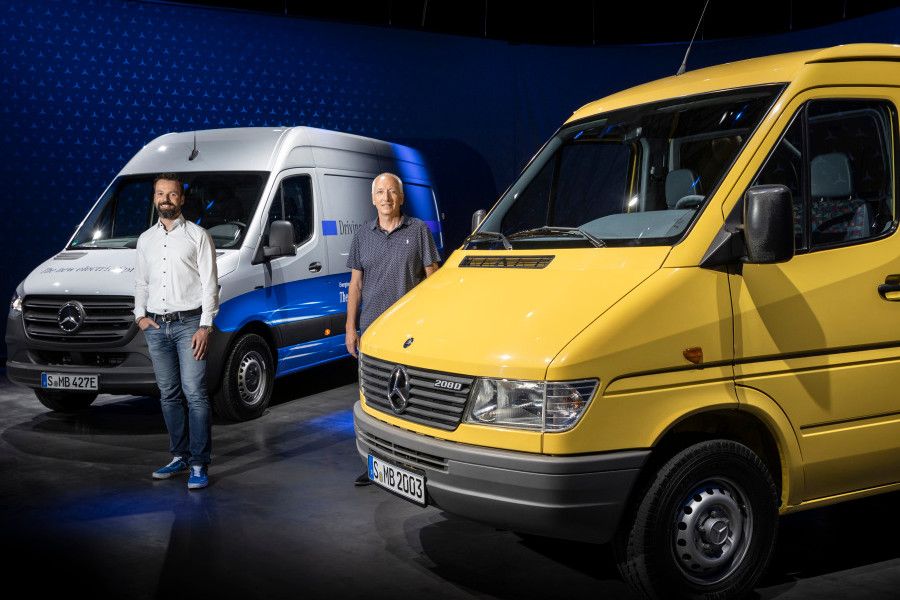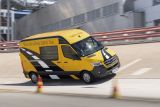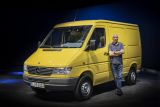Versatile transport icon celebrates anniversary: The Mercedes-Benz Sprinter – 25 years of pioneering its segment

For a quarter-century now, the name Sprinter has been synonymous with an entire class of vehicles. With the highlights of the current generation and the eSprinter, Mercedes-Benz Vans has once again set standards for urban delivery traffic. To mark its 25th anniversary, Mercedes-Benz is dedicating the third episode of the Meet Mercedes DIGITAL news format to the Sprinter. The focus is not only on the current generation of vehicles: a journey through time leads through the success story of the van whose predecessors were already on the roads in 1955.
In the third episode of Meet Mercedes DIGITAL, Norbert Kunz, Head of Marketing Mercedes-Benz Sprinter, and Benjamin Kaehler, Head of eDrive@VANs, present the large van’s development and the highlights of the current Sprinter generation. The third generation revolutionises with a comprehensive online network and creates new possibilities for fleet management thanks to Mercedes PRO services and the multimedia system MBUX. The fully electric eSprinter by Mercedes-Benz Vans provides the sustainable solution for locally emission-free transports.
"The secret of the Sprinter’s success is its versatility which has been our top priority next to the focus on safety since its market launch in 1995. Thanks to its wide range of variants, it is also the first choice when it comes to solutions for upfitters", states Norbert Kunz. The versatility of the van has always included a wide range of engine, transmission and powertrain variants. "The eSprinter continues the Sprinter's tradition of offering diversity in terms of powertrains as well as the consistent electrification of Mercedes-Benz Vans’ product portfolio", Benjamin Kaehler explains. "It offers the possibility of delivering goods, driving to the construction site or carrying out service work - and all in a future-oriented, locally emission-free manner."
The current Sprinter generation: Holistic mobility solutions following the adVANce philosophy
The third Sprinter generation combines progressive design with comfort and safety features normally only found in passenger cars. The comprehensive connectivity options are revolutionary for the commercial environment: The services of Mercedes PRO connect and the multimedia system MBUX (Mercedes-Benz User Experience) create new possibilities for the management of large fleets as well as for small businesses. For example, orders can be controlled online and vehicle information such as location, fuel level or maintenance status can be checked almost in real time. Eight packages with centralised services are available for Mercedes PRO connect.
The Sprinter's range of variants remains impressive: More than 1,000 different versions can be assembled from the possible combinations of bodies, chassis, drive concepts, tonnages and equipment details alone. In the third generation, more options are also offered for the powertrain with front-wheel drive available for the first time and two newly developed transmissions such as the 9-speed automatic torque converter transmission. With these drive variants and the so-called tractor head, the current Sprinter is ideal for conversion to a motorhome - an offer that numerous upfitters in this expanding segment are taking advantage of.
The eSprinter: On the road with zero local emissions
The eSprinter celebrated its Job No.1 at the end of 2019 and is making an essential contribution to turning the vision of locally emission-free delivery traffic into reality. It is just as economical, reliable and flexible as before when it comes to distributing goods, visiting construction sites or going out for service work - but performs these tasks with zero local emissions. Its electric front wheel drive delivers up to 85 kW (peak performance) with a torque of up to 295 Newton meters. A variable charging and battery concept takes individual needs into account: with a usable battery capacity of 47 kWh, the range is 168 kilometres*,** with a maximum payload of 891 kilograms.
A second battery option prioritises other parameters: the configuration with a usable battery capacity of 35 kWh (installed: 41 kWh) enables a range of 120 kilometres1, 2. In return, the maximum payload increases to 1,045 kilograms. Flexibility is also provided with the integrated fast-charging function which allows the battery to be charged from 10 percent to 80 percent within approximately 25 minutes. The top speed can also be configured to suit the purpose: to a maximum speed of 80 km/h, 100 km/h or 120 km/h.
For many fleet operators, it is important to precisely analyse feasibility, economy and efficiency before switching to electric drives. Typical driving profiles, operating times, ranges as well as loading times are decisive parameters and require a holistic approach. As part of its eDrive@VANs strategy, Mercedes-Benz Vans has taken this need into account and established an ecosystem for this shift in individual mobility. Key aspects of the service include consulting and supporting apps and tools for selecting the vehicle and the required charging infrastructure, for determining driving profiles and for considering the total cost of ownership.
The Sprinter: a synonym for its segment for 25 years
Since 1995, the Mercedes-Benz Sprinter has defined the size segment between 3.0 and 5.5 tons, has been known worldwide and on the road in more than 130 countries with almost four million units built. The Sprinter contributed to the transition to e-commerce: at a time when hardly anyone could have imagined the dimension of online trade we have today, the Stuttgart brand presented a state-of-the-art van that was perfect for the logistics challenges ahead.
Each generation has set standards, particularly in terms of safety, ergonomics, efficiency and comfort. As an example, Mercedes-Benz was the first van manufacturer to introduce the anti-lock braking system ABS as standard equipment already 1995, the Electronic Stability Program ESP in 2002 and Crosswind Assist in 2013.
Van expertise since 1955
Even the first Sprinter generation was nothing less but the result of 40 years of van expertise at Mercedes-Benz, as the Mercedes-Benz L 319 celebrated its debut in 1955. As the first transporter with the star on its radiator grille, it had a gross vehicle weight of 3.6 tons which was mobilised by the 43 hp diesel engine of the 180 D passenger car.
In 1967, the T2 series, known as the "Düsseldorf Transporter" and manufactured for almost 30 years, revolutionised the van market. Power steering, later on even an automatic transmission and up to 130 hp diesel engines as well as noticeably better soundproofing brought comfort and ergonomics into focus.
The "Bremen Transporter" or T1, introduced in 1977, is considered the direct predecessor of the Mercedes-Benz Sprinter. For the first time, the series was equipped with front disc brakes. Later, ABS and air conditioning systems represented further innovations in the commercial vehicle segment.
* The range was determined on the basis of Regulation 692/2008/EC. The range depends on the vehicle configuration.
** The actual range also depends on the individual driving style, road and traffic conditions, outside temperature, use of air conditioning/heating etc. and may vary.
Source of information
Daimler and ProfiBusiness.world
Date
February 3, 2021
Fotogalerie
Translator
News and information
Agriculture
Animals and pet supplies
Automotive
Banking and insurance
Boats and shipping industry
Building and architecture
Business
Education
Electrical industry
Electronics
Engineering
Environment
Finance, taxes and accounting
Flowers and plants
Food and beverage industry
For companies
Forestry and wood processing
Furniture
Gastronomy and hotel industry
Glass, ceramics and porcelain
Healthcare and pharmacy
Hobby and garden
Home and household goods
HR
Hygiene, drugstore and cosmetics
Charity and social responsibility
Chemical
Institution
IT and computers
Law and legislation
Management and certification systems
Minerals
Office
Packaging and packaging technologies
Paper industry
Plastic and rubber industry
Power engineering
PR and marketing
Printing and printing technology
Railway industry
Real estate
Safety, security and protection
Science and research
Social services
Sport and relax
Steel and iron processing
Telecommunications and the internet
Textile and leather industry
Tourism
Toys, games and entertainment
Transport and logistics









